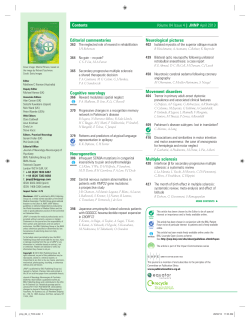
Document 282343
Downloaded from jnnp.bmj.com on October 6, 2014 - Published by group.bmj.com Letters to Editor should be mentioned at the outset that the accuracy of the applied method is limited' (Panayiotopoulos and Scarpalezos, 1975). Problem 2 The factors of error involved in the motor axon counting technique would affect disproportionately the results in health, denervation, and muscular dystrophy, thus precluding comparative studies between them. 1. In denervation, although the 'alternating' phenomenon (McComas et al., 1971) is less troublesome (Panayiotopoulos and Scarpalezos, 1975), the additive summation of newly recruited MUP is less satisfactory than in control subjects (McComas et al., 1971b; Panayiotopoulos and Scarpalezos, 1975). Moreover, ephaptic activation of degenerated motor axons cannot be totally excluded. 2. In Duchenne muscular dystrophy the factors of error contributing to an underestimation of the number of motor axons are much greater than in healthy subjects and denervation (a detailed discussion can be found in Panayiotopoulos (1976) as well as in previous reports: Scarpalezos and Panayiotopoulos, 1973; Panayiotopoulos et al., 1974). It would be also impossible with the 'new methods' to determine 'the firing levels' of 'small MU (which) could make an undetectable contribution to the surface EMG' (Brown et al., 1976). One might ask why we applied the method in neuromuscular diseases despite our awareness of the above several problems. Our purposes were (a) to point out the fundamental difficulties of the original technique, results from which were considered the strongest evidence to support the neurogenic hypothesis, and (b) to show that by approximately equalising the factors of error between health and muscular dystrophy there is in fact no loss of motor axons in muscular dystrophy and that 'the neurogenic hypothesis is based on poor and vulnerable evidence' (Panayiotopoulos and Scarpalezos, 1975; Panayiotopoulos et al., 1976). McComas has recently participated in an experimental 'study which provides direct evidence against a neuropathogenesis for murine dystrophy' (Law et al., 1976). In the results of the 'new methods' (Milner-Brown and Brown, 1976) two out of four cases of muscular dvstrophy have numbers of motor units below the lowest normal value. In view of the recent work (Law et al., 1976) the above findings may be an indirect evidence that the 'new methods' do not equalise the factors of error between health and muscular dystrophy. In conclusion, we believe that the above main and other problems of the motor axon counting technology should be vigorously discussed and tested if 'new methods' and 'new results' are to be presented in the future. C. P. PANAYIOTOPOULOS Eginition Hospital, 74, Vasilissis Sophioy A v., A thens, Greece. 929 SIR.-Our intention in the papers (Brown and MilnerBrown, 1976; Milner-Brown and Brown, 1976) has been to highlight errors in the method originally proposed to estimate motor unit numbers (McComas et al., 1971a), and report modifications that can correct for one of the most important errors: the fluctuation in the electrical excitability and overlap in the firing levels of motor axons. The modifications are part of a continuing programme to develop a method, acceptable to patients, and capable of providing accurate quantitative estimates of the number of motor units (MU) in muscles. Differences in the latencies from the stimulus shock to maximum voltage(s) in MU can partially, indeed completely, hide the voltage contribution of MU to the incremental sum, particularly if the range in latencies of the single MU is large. Precisely for that reason we have stated that MU isolated using isometric contraction, F discharge, or multiple point stimulation cannot be used directly to calculate a mean MU potential voltage (Feasby and Brown, 1974; Milner-Brown and Brown, 1976). These methods were, however, used to isolate single MU in order to indicate the presence of large MU in the muscle and to emphasize how unrepresentative the sample of MU used in calculating the mean motor unit potential (MMUP) are. In 'problem 1', Dr Panayiotopoulos states that 'The most essential requirement is that the MUP be summated in a precisely additive manner'. The lack of temporal coincidence of the potential maxima of individual MU is evident, and has been quantitatively illustrated by comparing the mean amplitudes of MUP obtained directly from incremental responses with MUP isolated using graphical subtraction (Panayiotopoulos et al., 1974), or computer methods (Ballantyne and Hansen, 1974; Brown et al., unpublished). However, in the original method (McComas et al., 1971a) and our modified methods (Milner-Brown and Brown, 1976), the probable 'error', due to the lack of temporal coincidence of potential maxima of individual MU, is inherent in both the summation of the compound potential (CP) of the first 10 MU used in calculating the MMUP as well as the maximum CP. As there is no obvious reason to suggest that the algebraic summations are not the same in both CPs, the probable 'errors' should cancel out when the maximum CP is divided by the MMUP. Therefore, the relative importance of the pattern of summation in the overall MUP seems to have been overemphasised by Dr. Panayiotopoulos. Panayiotopoulos and colleagues seemed to imply that their modified method was an improvement on the original method, because in their method 'an effort was made to minimise the possibility of missing small amplitude MUAP' (Panayiotopoulos et al., 1974; Panayiotopoulos and Scarpalezos, 1975). In a recent study we showed that motor units are excited in order from small to large by graded increases in the stimulus intensity (Kadrie et al., 1976). Therefore, the case for exclusion of the very small MU by the Downloaded from jnnp.bmj.com on October 6, 2014 - Published by group.bmj.com Letters to Editor 930 original method has been overstated, the methods and observations on which it has been based being incorrect. The recognition cf the voltage contribution of single MU to the surface record depends on the potential steps occurring in an all-or-nothing manner, the 'all' responses being clearly reproduceable in configuration and beyond the possible errors introduced by noise, stimulus artefact, and the inclusion of out of order summation 'alternation' potentials. In our opinion, none of the above conditions is met by the methods reported by Panayiotopoulos et al. (1974). In conclusion, we would like to add that, even though no method for estimating MU numbers has been found to date that is entirely acceptable, the two modified methods incorporating an important correction should help to make the method of estimating MU numbers more accurate. However, it is premature in our opinion to hypothesise on the aetiology of neuromuscular disorders based on data obtained frcm motor unit estimates alone. WILLIAM F. BROWN H. S. MILNER-BROWN Department of Clinical Neurological Sciences, Division of Neurology, University Hospital, London, Ontario. REFERENCES Ballantyne, J. P., and Hansen, S. (1974). New method for the estimation of the number of motor units in a muscle. 1. Control subjects and patients with myasthenia gravis. Journal of Neurology, Neurosurgery, and Psychiatry, 37, 907-915. Ballantyne, J. P., and Hansen, S. (1975). Computer method for the analvsis of evoked motor unit potentials. 2. Duchenne, limb-girdle, facioscapulohumeral and myotonic muscular dystrophies. Journal of Neurology. Neurosurgery, and Psychiatry. 38, 417-428. Brown, W. F., and Milner-Brown, H. S. (1976). Some electrical properties of motor units and their effects on the methods of estimating motor unit numbers. Journal of Neurology, Neurosurgery, and Psychiatry, 39, 249-257. Brown, W. F., Milner-Brown, H. S.. and Drake, J. (1976). Sources of error in methods for estimating motor unit numbers. In Recent Advances in Myology (Proceedings of the IlIrd International Congress on Muscle Diseases, Newcastle upon Tyne, September, 1974), pp. 108-115. Edited by W. G. Bradley, D. Gardner-Medwin, J. N. Walton. Excerpta Medica American Elsevier. Feasby, T. E.. and Brown, W. F. (1974). Variation of motor unit size in the human extensor digitorum brevis and thenar muscles. Journal of Neurology, Neurosurgery, and Psychiatry, 37, 916-926. Kadrie, H. A., Yates. S. K., Milner-Brown, H. S., and Brown, W. F. (1976). Multiple point electrical stimulation of ulnar and median nerves. 1. Rank order of recruitment of motor units. 2. Axonal branching. Journal of Neurology, Neurosurgery, and Psychiatry. (In press). Law, P. K., Cosmos. E. Butler, J., and McComas. A. J. (1976). Absence of dystrophic characteristics in normal muscles successfully cross-reinervated by nerves of dystrophic genotype: physiological and cytochemical study of crossed solei of normal and dystrophic parabiotic mice. Experimental Neurology, 51, 1-21. McComas, A. J., Fawcett, R. R. W.. Campbell, M. J., and Sica, R. E. P. (1971a). Electrophysiological estimation of the number of motor units within a human muscle. Journal of Neurology, Neurosurgery, and Psychiatry, 34, 121-131. McComas, A. J., Sica, R. E. P., and Campbell, M. J. (1971b). 'Sick' motoneurones. A unifying concept of muscle disease. Lancet, 1, 321-325. Milner-Brown, H. S., and Brown, W. F. (1976). New methods of estimating the number of motor units in a muscle. Journal of Neurology. Neurosurgery, and Psych.atry, 39, 258-265. Panayiotopoulos. C. P. (1976). Workshop on the aetiology of Duchenne Muscular Dystrophy. In Recent A dvances in Myology (Proceedings of the IlIrd Interniational Congress on Muscle Diseases, Newcastle upon Tyne, Scptember, 1974), pp. 159162. Edited by W. G. Bradley, D. Gardner-Medwin, J. N. Walton. Excerpta Medica American Elsevier. Panayiotopoulos, C. P., and Scarpalezos, S. (1975). Electrophysiological estimation of motor units in limb-girdle muscular dystrophy and chronic spinal muscular atrophy. Journal of Neurological Sciences, 24, 95-107. Panayiotopoulos, C. P., Scarpalezos, S. and Papapetropoulos. Th. (1974). Electrophysiological estimation of motor units in Duchenne muscular dystrophy. Journal of N'eurological Sciences. 23, 89-98. Panayiotopoulos, C. P., Scarpalezos, S., and Papapetropoulos, Th. (1976). Electrophysiological estimation of motor units in neuromuscular diseases. In Recent Advances in Myology (Proceedings of the IlIrd International Congress on Muscle Diseases. Newcastle upon Tyne, September, 1974), pp. 91-98. Edited by W. G. Bradley, D. Gardner-Medwin, J. N. Walton. Excerpta Medica: Amsterdam. Scarpalezos, S., and Panayiotopoulos. C. P. (1973). Duchenne muscular dystrophy: reservations to the neurogenic hypothesis, Lancet. 2, 458. Downloaded from jnnp.bmj.com on October 6, 2014 - Published by group.bmj.com Letters William F. Brown and H. S. Milner-Brown J Neurol Neurosurg Psychiatry 1976 39: 929-930 doi: 10.1136/jnnp.39.9.929 Updated information and services can be found at: http://jnnp.bmj.com/content/39/9/929.citation These include: Email alerting service Receive free email alerts when new articles cite this article. Sign up in the box at the top right corner of the online article. Notes To request permissions go to: http://group.bmj.com/group/rights-licensing/permissions To order reprints go to: http://journals.bmj.com/cgi/reprintform To subscribe to BMJ go to: http://group.bmj.com/subscribe/
© Copyright 2025









